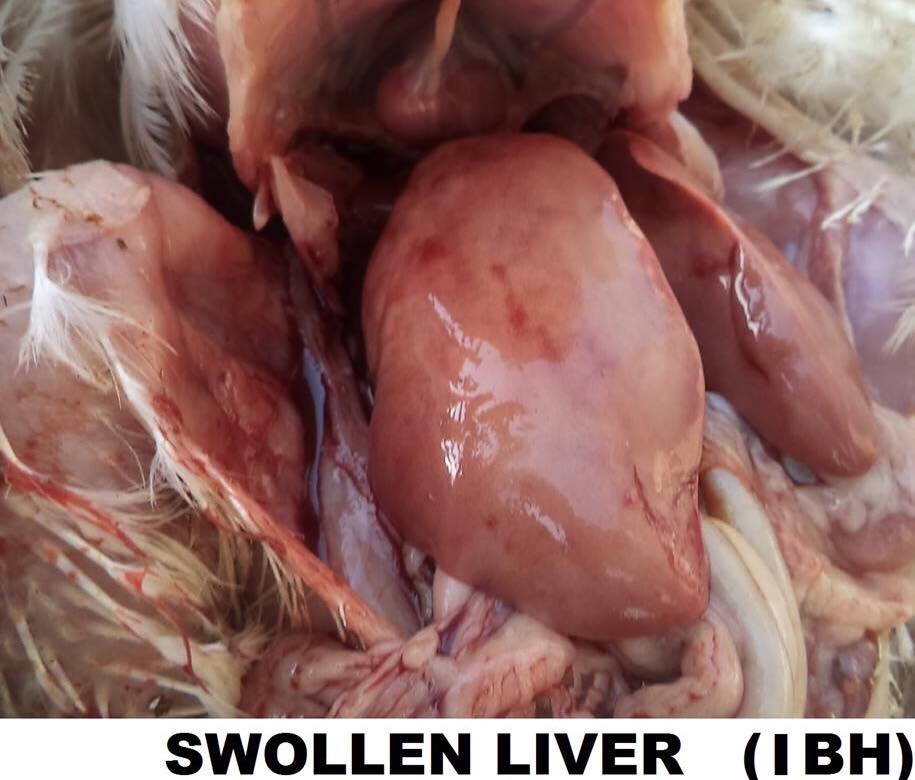IBH (INCLUSION BODY HEPATITIS) IN CHICKEN

Inclusion body hepatitis (IBH) is an acute liver disease caused by fowl adenovirus (FAdV). It affects chickens of all age groups worldwide. IBH is a frequent problem for the commercial poultry industry, specifically seen in broilers and broiler breeder flocks. Affected flocks are often co-infected with other immunosuppressive viruses such as infectious bursal disease virus or chicken infectious anemia virus which predispose birds to developing IBH.
Inclusion body hepatitis (IBH) associated with fowl adenovirus (FAdV) infection has occurred worldwide and resulting in considerable economic losses to the poultry farmers. It is an acute disease of chicken caused by the virus of the genus Aviadenovirus and referred to as fowl aviadenovirus (FAdV). There are 12 FAdV types (FAdV1 to FAdV8a and FAdV8b to FAdV11), classified into five species based on their genotype (designated FAdV A to FAdV E). All most all serotypes are involved in causation of IBH. It normally occurs in meat-type chickens at 3 to 7 weeks of age, but it has been reported in birds as young as 2 day-old and as old as 20 weeks. High mortality occurs when the affected birds are less than three weeks of age. Depending on the pathogenicity of the virus, immune status of the chicks and concurrent secondary infections, mortality may reach up to 80 percent.
Transmission
Horizontal and vertical transmission plays an important role in IBH. The virus transmits vertically through embryonated eggs. Horizontal transmission of fowl adenovirus occurs by the oral – faecal route and further spread takes place by mechanical means and by contamination with infected faeces.
Clinical signs
Sudden mortality is found in birds of 4 days old up to 6 weeks. Mortality generally ranges from 40-60%. In many cases the IBH can be a primary disease in broiler chicken without any immunosuppression and it causes low morbidity and mortality ranges between 10 to 30% and it can reach up to 80% in the presence of other immunosuppressive factors. Affected birds showed reduced feed and water intake, lethargic, hurdling with ruffled feather, yellow droppings and in some flocks showed leg weakness.
SIGNS
• Watery dropping
• Depression
• Inappetance
• Ruffled feathers
• Pallor of comb and wattles
• Kidneys are enlarged, pale and mottled with multiple hemorrhages
• Lost body weight
• Diarrhea
• Anorexia
• Anemia and dehydration may develop secondary to hemorrhagic enteritis
• Sometimes the skin is icteric
• Often ecchymoses and striated haemorrhages skeletal muscles are observed.
Post mortem lesions

• Liver swollen, yellow, mottled with petechlae and. Ecchymoses
• Kidneys and bonemarrowpale
• Blood thin
• Bursa and spleen small
On necropsy examination affected birds showed ascites, enlarged pale, friable and mottled liver. The kidneys are pale, swollen and mottled appearance. Haemorrhage into the renal cortex may be found in some of the birds.

Histopathological examination
Classical IBH is characterized by focal hepatic necrosis and presence of intranuclear inclusion bodies in hepatocytes.. Congestion and focal hemorrhage are observed in kidneys. In many of the hepatic cells, the nuclei disappear entirely, leaving a ghost cell consisting of one or more large vacuoles. Varying degrees of pyknosis, karyorrhexis and karyolysis are observed in the majority of the hepatic cells.
Diagnosis
• Diagnosis of IBH is based on both conventional and molecular techniques.
• Conventionally IBH can be diagnosed based on the clinical signs, gross pathology, histopathology and serological techniques.
• Histological investigations and detection of intranuclear inclusion bodies in hepatocytes.
• Isolation of fowl adenovirus using chicken embryo liver culture and identification by PCR and real time PCR.
• Serotyping of fowl adenovirus using PCR combined with RFLP, sequencing and High Resolution Melting curve analysis of hexon gene .
Prevention and control
• Cenrantive and good sanitary precautions, prevention of immunosuppression. Adenovirus infection may infect other organs causing a splenits inclusion body hepatitis, bronchitis, pulmonary congestion ventriculitis, oedema depending on the species of bird infected.
• The immunosuppressive viruses like infectious bursal disease virus and chicken infectious anaemia viruses potentiate these diseases. So, the major step should be to eliminate these two agents.
• Feed should be free of mycotoxin
• Implementation of proper winter management programme
• Appropriate biosecurity measures should be maintained.
• Infected and non-infected breeding flocks should be separated.
• Vaccination of breeder flock with serotype specific fowl adenovirus vaccine.
Inclusion body hepatitis is a recently reemerged fowl adenoviral disease of meat type chicken. The control of disease is difficult due to involvement of many fowl adenovirus serotypes causing disease. It should eliminated from the poultry flock by strict implementation of biosecurity measures, routine screening of flocks for other immunosuppressive diseases and proper vaccination programme

